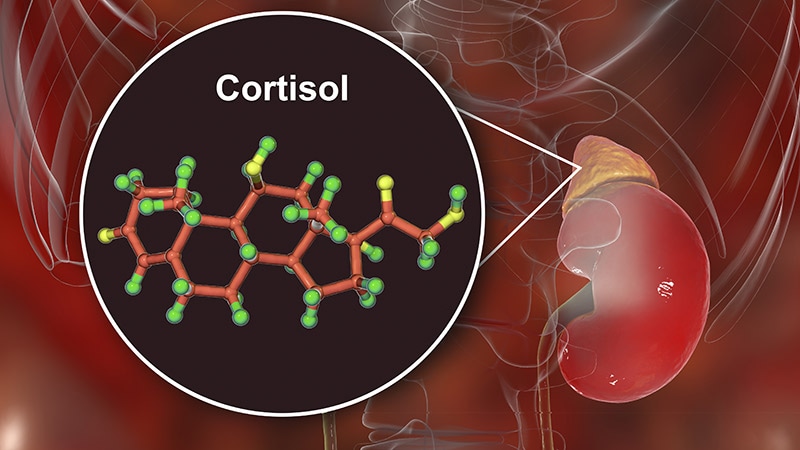Discovery of Precursor Lesions to Cortisol-Producing Adrenal Tumors: Insights into Adrenal Cortex Pathogenesis
Core Concepts
Cortisol-producing adrenal adenomas (CPAs) are preceded by the development of steroids-producing nodules (SPNs) with distinct tumorigenic and tumor-suppressive layers, providing insights into the pathogenesis of adrenal cortex tumors.
Abstract
The study examined tissue samples from 74 patients who underwent adrenalectomy, including 12 with CPA. The researchers found that the tissues adjacent to the CPA tumors harbored nodular structures with two distinct layers: an outer zona fasciculata (zF)-like layer that enhanced cell proliferation, and an inner zona reticularis (zR)-like layer that had a tumor-suppressive effect with increased immune gene expression and macrophage presence.
The zF-like layer was identified as the main driver for CPA development, as cells in the adrenal cortex with CPA-associated gene mutations (e.g., GNAS) developed into these SPNs. The researchers suggest that the layered structure of the SPNs creates a microenvironment conducive to CPA formation.
Further analyses showed that patients with higher expression of immune-related genes in the zR-like layer had better prognosis, indicating the potential role of the immune system in adrenal tumor development. The study provides a new pathological entity of these SPNs and highlights the need for larger studies to understand the prevalence and clinical implications of these precursor lesions.
Potential Precursor Lesion to Adrenal Tumors Identified
Stats
The study examined tissue samples from 74 patients who underwent adrenalectomy, including 12 with cortisol-producing adrenal adenomas (CPAs), 56 with aldosterone-producing adenomas, 2 with nonfunctioning adrenocortical adenomas, 2 with adrenal ganglioneuromas, and 2 with adrenal myelolipomas.
In 6 of the 12 tumor-adjacent CPA samples, the researchers found adrenocortical nodular structures with two distinct layers: an outer zona fasciculata (zF)-like layer and an inner zona reticularis (zR)-like layer.
All but one of the sampled steroids-producing nodules (SPNs) harbored GNAS mutations, which were not observed in the atrophied adrenocortical tissue surrounding the tumor-adjacent samples.
Patients with high median expression levels for the top 10 differentially upregulated immune-linked genes in the zR-like layer of the SPNs had a better prognosis than those with low expression.
Quotes
"We also found that this zF-like structure was the main cause for the development of CPAs."
"We hope our results will advance our understanding of the layered structure of the adrenal cortex and can lead to the prevention and treatment of adrenal cortex atrophy in the future."
"The authors did a fantastic job to characterize these nodules with an impressive level of detail. I'm not a pathologist, but this type of nodule will likely become a new pathologic entity. Perhaps this is the most important contribution of this study."
Key Insights Distilled From
by Liam Davenpo... at www.medscape.com 05-23-2024
https://www.medscape.com/viewarticle/potential-precursor-lesion-adrenal-tumors-identified-2024a10009rl
Deeper Inquiries
What are the potential clinical applications of understanding the role of these steroids-producing nodules in the development of cortisol-producing adrenal adenomas?
The understanding of steroids-producing nodules (SPNs) and their role in the development of cortisol-producing adenomas (CPAs) can have significant clinical implications. By identifying these precursor lesions, clinicians may be able to detect individuals at risk of developing CPAs earlier. This early detection could lead to improved monitoring strategies for patients with SPNs, potentially allowing for timely intervention before the progression to CPAs. Additionally, insights into the molecular mechanisms underlying the transition from SPNs to CPAs could pave the way for the development of targeted therapies aimed at preventing the development or progression of adrenal tumors. Understanding the pathogenesis of CPAs through SPNs may also enhance risk stratification and personalized treatment approaches for patients with adrenal tumors.
How might the immune system's interplay with the local microenvironment of these nodules influence adrenal tumor progression, and what are the implications for targeted immunotherapies?
The interplay between the immune system and the local microenvironment of steroids-producing nodules (SPNs) can significantly influence adrenal tumor progression. The presence of macrophages in the non-tumorigenic layer of SPNs suggests an immune response within the adrenal cortex that may impact tumor development. The increased presence of macrophages and upregulation of immune-related genes in the zR-like layer of SPNs indicate a potential tumor-suppressive effect. Targeting the immune microenvironment of SPNs through immunotherapies could offer novel treatment strategies for preventing the progression of SPNs to cortisol-producing adenomas (CPAs). By modulating the immune response within the adrenal cortex, targeted immunotherapies may help in controlling tumor growth and improving patient outcomes in adrenal tumor management.
Could the prevalence and accumulation of these precursor lesions with age provide insights into the broader epidemiology and risk factors for adrenal cortex tumors in the general population?
The prevalence and accumulation of precursor lesions such as steroids-producing nodules (SPNs) with age could offer valuable insights into the broader epidemiology and risk factors for adrenal cortex tumors in the general population. Understanding the natural history of SPNs and their potential progression to cortisol-producing adenomas (CPAs) over time may shed light on the age-related incidence of adrenal tumors. Investigating the prevalence of SPNs in different age groups and correlating their accumulation with the development of CPAs could help identify age-related risk factors for adrenal cortex tumors. Furthermore, studying the relationship between aging and the formation of SPNs may provide clues about the underlying mechanisms driving adrenal tumor initiation and progression in the general population. This knowledge could contribute to improved screening strategies and risk assessment for adrenal tumors across different age demographics.
0
